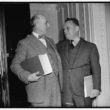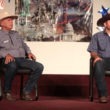The landscape that Basic Rights Oregon has set out to change was redefined in 2004, when Republicans and evangelical Christians forced initiatives prohibiting same-sex marriage onto ballots in 11 states.
Ohio’s ballot initiative got most of the media coverage, because it was a state that George W. Bush had to win in order to be reëlected.
The outcome of Ohio’s Ballot Measure 1 vote was predictable, considering the state’s anti-gay political climate. A law that banned single-sex marriage was already on the books in February 2004, when the Legislature passed another law that prohibited state courts from recognizing same-sex marriage performed in other states. While a constitutional amendment that defined marriage exclusively as a union between a man and a woman, and also banned recognition of any kind of domestic union might have been redundant, there was little doubt that it would be ratified by the state’s voters.
Driven to the polls by Christian-right pastors in the state, and by Christian-right radio and television outside the state, the voters of Ohio doubled down on their state’s two anti-gay-union statutes. On the day President George W. Bush defeated Senator John Kerry by 136,483 votes in the state (out of 5,445,811 votes cast), the anti-gay ballot measure won 60 percent of the vote. The ban on same-sex marriage and domestic unions was written into Ohio’s state constitution. Exit polls found that voters who call themselves evangelicals or born-again Christians supported Measure 1 by an 86 to 14 percent margin.
The same story repeated itself across the country, as right-wing politicians exploited the Massachusetts Supreme Court’s 2003 decision to allow same-sex marriage.
No smart money was bet against anti-gay-marriage ballot measures in Arkansas, Georgia, Kentucky, Michigan, Montana, North Dakota, Oklahoma, Ohio, Texas or Utah — where they passed by a comfortable margin.
PORTLANDIA?—Oregon promised a different narrative. The state’s population was concentrated along the I-5 corridor, in progressive cites like Portland and Eugene. Legislators in Salem openly discussed the practical importance of “gay-friendly” legislation to sustain the state’s “creative class” and promote economic growth. And since 1988, gay and lesbian advocacy groups had beaten back three successive anti-gay ballot initiatives.
When the Christian-right Defense of Marriage Council collected more than twice the signatures necessary to place a same-sex marriage measure on the November ballot, Oregon became the Rio Manzanares of the LGBT movement (lesbian, gay, bisexual, and trans-gender).
The National Gay and Lesbian Task Force contributed $529,536 to the campaign to defeat Measure 36, the ballot measure that would write the prohibition of same-sex marriage into the state’s constitution. Denver software millionaire Tim Gill contributed $100,000. The $1.4 million raised by opponents of the anti-gay measure far surpassed the $660,000 raised by its proponents, led by the Defense of Marriage Council.
When the votes were counted, defenders of gay and lesbian marriage rights lost by a 43 percent to 57 percent margin. Measure 36 carried all but two of Oregon’s 36 counties: Multnomah County, which includes the city of Portland; and Benton County, home to Oregon State University in Corvallis. Voter turnout was driven, in part, by an engineered backlash to an earlier decision by Multnomah County officials to allow same-sex marriages.
Anti-gay ballot measures were not a novelty in Oregon. In 1988, Democratic Governor Neil Goldschmidt issued a modest executive order prohibiting discrimination against gays and lesbians, which applied to all executive offices. Social conservatives gathered enough signatures to challenge the governor’s executive order at the polls, where they prevailed.
In 1992, an Oregon appeals court overturned the voter-approved response to Goldschmidt’s order, but a Christian group called the Oregon Citizen’s Alliance placed a far more sweeping measure on the ballot, barring the use of state funds to “promote, encourage or facilitate homosexuality, pedophilia, sadism or masochism.” The measure also would have required public schools to teach that those practices were “abnormal, wrong, unnatural and perverse.” It was rejected by 55 percent of the voters.
In 1994, the same anti-gay organization succeeded in getting another measure on the ballot, barring any government official from classifying gays or lesbians as a minority. Gay-rights activists defeated it 51-49 percent.
The 2004 vote was a redefining moment for Oregon’s LGBT community. After the prohibition of same-sex marriage was written into the state constitution, the leaders of Basic Rights Oregon reconsidered their strategy.
“We’ve done two decades of ballot fights, but it’s always been on someone else’s timeline,” Frazzini told me. “This time, it will be on our own terms.”
“Their terms” mean they will refer a same-sex marriage initiative to Oregon’s voters after conducting an open-ended program of education and polling. BRO has broken out of the campaign cycle.
Basic Rights Oregon came together in 1996. It now has an annual budget of $1.2 million and a staff of 16. (“That’s our ongoing organizational budget,” Frazzini said in response to my question. “Ad campaigns can inflate your budget.”) It houses two political action committees: a state-candidate PAC and a ballot-measure PAC. And it has enlisted 5,000 volunteers.
In a job posting with an executive headhunting agency earlier this year, BRO took credit for leading the campaign through which “Oregon came closer than any other state to defeating a marriage amendment” in 2004. The posting doesn’t mention that “closer” meant a 14 percent loss.
It is the 2004 election results that inform the organization’s departure from tactics used in earlier campaigns.
NEW PARADIGM—”We are doing this slow and steady, outside the heat of a political campaign,” Frazzini said. “The piece we have been sorting out for the past three years is the larger idea of methodically and strategically figuring out how to engage the public and significantly change hearts and minds over the course of a number of years, on an issue that has been politically charged.”
Basic Rights Oregon’s organizing director Thomas Wheatley described a three-year research, testing and experimentation program to “figure out how to engage the public in a long-term discussion about the freedom to marry, and what it means to exclude same-sex couples from the institution of marriage.”
Frazzini described a process by which BRO would change its campaign paradigm.
To change the paradigm, BRO has brought on the Analyst Institute, which Wheatley describes as a consulting firm “on the leading edge of evidence-based research in engaging voters for the progressive side.”
The institute was founded in 2007 by AFL-CIO officials and liberal political operatives, according to an October 2010 profile in the New York Times Sunday magazine. It is managed by Todd Rogers, a behavioral scientist who directed what the Times described as “dozens of experiments around the country” in 2010.
Rogers started out following the work of Hal Malchow, a political consultant who became intrigued with the “experimental movement” in politics, which began with two Yale political scientists in 1998. The “experiments” Wheatley mentioned gauge voter reaction to messages in near-real time and then refine the messages based on voter response. The data-driven campaigns based on the experimental-movement model often turn convention on its head.
For example, after Texas Governor Rick Perry invited the Yale political scientists who founded the experimental-politics model to work inside his 2006 general election campaign, he applied their advice in his 2010 gubernatorial primary campaign against U.S. Senator Kay Bailey Hutchison.
In 2010 the Perry campaign abandoned direct mail, paid phone calls, lawn signs, meetings with newspaper editorial boards, and ads in newspapers. The campaign focused on 18 media markets (Texas is a big state) and 80 radio stations, to beat Hutchison by 20 points.
THE MEDIUM IS THE MESSAGE—Wheatley said that BRO worked with the Analyst Institute and used experimental-politics techniques “to determine our approach to the conversation with voters.”
“Should we be talking about rights and benefits of same-sex couples or should we be helping demonstrate that same-sex couples and opposite-sex couples want to marry for very similar reasons?” Wheatley said. “Because marriage is a public vow. It’s about love and commitment. It’s a promise you make to the person you want to grow old with.”
“The research has shown very clearly, in focus grouping, polling and real-world tests, that this conversation ought to be a personal one,” Wheatley said.
The most visible result of the research is a series of TV spots, which a business lobbyist who has served in both houses of the Oregon Legislature told me were “some of the most moving ads I’ve ever seen.”
The ads feature conventional couples, gay and straight, black and white, describing their long-time commitment to their partners. Not actors, but married Oregonians, mostly over 40 years of age, discussing their relationships. One particularly effective ad, according to the lobbyist, features an African-American family describing their commitment to their gay son.
Unlike Texas, Oregon is almost one big media market.
“The Portland market alone includes 22 of the state’s 36 counties,” Wheatley said. “There are other, smaller markets. Three in particular, in Eugene, Medford, and Bend. We’ve done the television ads — and door-knocking, direct mail, and grassroots organizing in all of those markets,” Wheatley said. The various components of the campaign are then tested and refined based on the test results.
Asked about testing, Wheatley slips into experimental-politics talk: “We have tested and measured the impact of our public education strategies for the marriage campaign. The evaluation method in these experiments is a lot like a science experiment where you select voters at random and segment them into groups that receive different kinds of educational communications — for example, seeing different TV commercials. Then you use phone surveys to see which approach had more impact. This kind of rigorous evaluation is a very powerful tool in a multi-year effort. …”
Basic Rights Oregon is invested in a process rather than a campaign. Frazzini told me there is a “threshold poll number” they have resolved to reach before they take same-sex marriage to the voters, though she wouldn’t reveal it.
Wheatley did say that BRO has set a goal, before the fall, of turning 100,000 undecided voters into supporters of same-sex marriage. “We’ve knocked on about 30,000 doors over two summers to talk to voters,” he said. “This summer we will talk to 15,000 Oregonians face-to-face.”
“We will make a decision [on the 2012 ballot] sometime in late October,” Frazzini said. “We will repeat a second round of TV ads in Eugene, Medford, and Bend potentially, and do another similar program here in Portland. Then we’ll do additional polling and meet with partnership organizations we have worked with year in and year out.”
“We understand, given the experience of these 20-plus years, what’s at stake,” Frazzini said.
“This time it will be on our terms. When we are ready.”
POSTSCRIPT—Basic Rights Oregon works with a broad coalition of advocacy groups within and beyond the LGBT advocacy community. At 5:30 p.m. on the day I met with Frazzini and Wheatley in downtown Portland, I caught up with Wheatley at a union hall in southeast Portland. BRO has a working partnership with Service Employees International Union 503, and a few SEIU members were present. But this meeting was at a musician’s union hall and most in the enthusiastic crowd of more than 50 who showed up were not union members, but rather, members of Portland’s gay community.
They were younger, hipper, more pierced and tattooed than the earnest couples featured in BRO’s television and direct-mail campaigns, closer to what you would expect in the neighborhoods surrounding downtown Portland. Except for a couple of union members I spoke to, their experience with organized labor was limited. All of them seemed to be looking for a way to tie into Basic Rights Oregon’s marriage equality campaign.
The meeting had a distinct social-service-advocacy-group vibe: breaking into small groups, introducing yourself, opining on a selected topic, a peripatetic reading of a union organizing timeline that consisted of printouts taped to the walls in chronological clockwise order, and more discussion. There were warnings about dominating the group conversation. There was even the requisite food for functions sponsored by 501(c)(3) non-profits: wraps. (Sharing with your small-group members “the gender pronoun you prefer” was definitely LGBT-culture specific.)
There was also a large-group session in which labor unions and the history of institutional oppression of labor unions (and the gay and lesbian community) was discussed. As was the participants’ perception of labor unions.
The meeting was run by two young members of the BRO staff, who drew members of the group into a genuine discussion about organized labor.
The subtext was evident. Organized labor and the organized LGBT communities share a common history, common goals and common organizing strategies. And because labor unions have supported Basic Rights Oregon’s legislative agenda — and the marriage equality campaign — the gay and lesbian community needed to support organized labor.
There was nothing exciting about the event; it was typical of the hard and mostly invisible work required to cultivate a constituency and create a movement. When the meeting was over, I spoke to Wheatley, who had been observing and taking photos.
“This was the first time we’ve done this,” he said. “We will evaluate and discuss how it worked.”
He described it as part of BRO’s ongoing partnership with the SEIU, an attempt to bring non-union working people into a union hall to meet with union members. And to talk with union members about the right to marry.
“Everyone who was here tonight will be contacted after the meeting,” Wheatley said. “To sign them up with the Fair Wage For Workers Campaign we’re working on with the union.”





0 Comments